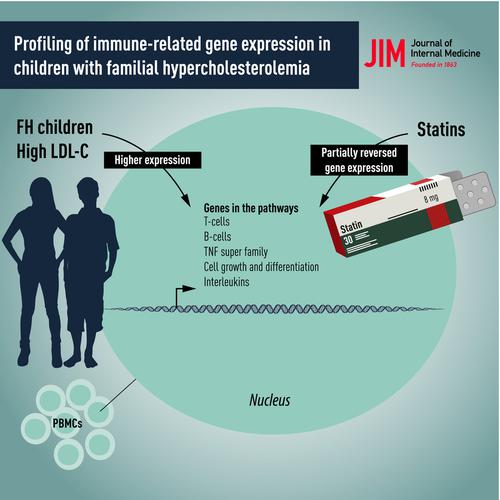当前位置:
X-MOL 学术
›
J. Intern. Med.
›
论文详情
Our official English website, www.x-mol.net, welcomes your
feedback! (Note: you will need to create a separate account there.)
Profiling of immune-related gene expression in children with familial hypercholesterolaemia.
Journal of Internal Medicine ( IF 9.0 ) Pub Date : 2019-10-21 , DOI: 10.1111/joim.13001 I Narverud 1, 2 , J J Christensen 1, 2 , S S Bakke 3 , S M Ulven 2 , A Rundblad 2 , P Aukrust 4, 5, 6 , T Espevik 3 , M P Bogsrud 1, 7 , K Retterstøl 2, 8 , T Ueland 4, 5, 9 , B Halvorsen 4, 5 , K B Holven 1, 2
Journal of Internal Medicine ( IF 9.0 ) Pub Date : 2019-10-21 , DOI: 10.1111/joim.13001 I Narverud 1, 2 , J J Christensen 1, 2 , S S Bakke 3 , S M Ulven 2 , A Rundblad 2 , P Aukrust 4, 5, 6 , T Espevik 3 , M P Bogsrud 1, 7 , K Retterstøl 2, 8 , T Ueland 4, 5, 9 , B Halvorsen 4, 5 , K B Holven 1, 2
Affiliation

|
BACKGROUND
Innate and adaptive immune responses are pivotal in atherosclerosis, but their association with early-stage atherosclerosis in humans is incompletely understood. In this regard, untreated children with familial hypercholesterolaemia may serve as a human model to investigate the effect of elevated low-density lipoprotein (LDL)-cholesterol.
OBJECTIVES
We aimed to study the immunological and inflammatory pathways involved in early atherosclerosis by examining mRNA molecules in peripheral blood mononuclear cells (PBMCs) from children with FH.
METHODS
We analysed the level of 587 immune-related mRNA molecules using state-of-the-art Nanostring technology in PBMCs from children with (n = 30) and without (n = 21) FH, and from FH children before and after statin therapy (n = 10).
RESULTS
176 genes (30%) were differentially expressed between the FH and healthy children at P < 0.05. Compared to healthy children, the dysregulated pathways in FH children included the following: T cells (18/19); B cells (5/6); tumour necrosis factor super family (TNFSF) (6/8); cell growth, proliferation and differentiation (5/7); interleukins (5/9); toll-like receptors (2/5); apoptosis (3/7) and antigen presentation (1/7), where the ratio denotes higher expressed genes to total number of genes. Statin therapy reversed expression of thirteen of these mRNAs in FH children.
CONCLUSION
FH children display higher PBMC expression of immune-related genes mapped to several pathways, including T and B cells, and TNFSF than healthy children. Our results suggest that LDL-C plays an important role in modulating expression of different immune-related genes, and novel data on the involvement of these pathways in the early atherosclerosis may represent future therapeutic targets for prevention of atherosclerotic progression.
中文翻译:

家族性高胆固醇血症儿童的免疫相关基因表达谱分析。
背景技术先天性和适应性免疫反应在动脉粥样硬化中起关键作用,但是它们与人类早期动脉粥样硬化的关系尚不完全清楚。在这方面,未经治疗的家族性高胆固醇血症儿童可以作为人类模型来研究低密度脂蛋白(LDL)-胆固醇升高的影响。目的我们旨在通过检查FH儿童外周血单核细胞(PBMC)中的mRNA分子,研究早期动脉粥样硬化所涉及的免疫和炎症途径。方法我们使用最新的纳米串技术分析了患有(n = 30)和不患有(n = 21)FH的儿童以及他汀类药物治疗前后的FH儿童的PBMC中587种免疫相关mRNA分子的水平。 (n = 10)。结果FH和健康儿童之间有176个基因(30%)差异表达,P <0.05。与健康儿童相比,FH儿童的失调途径包括:T细胞(18/19); T细胞(18/19)。B细胞(5/6);肿瘤坏死因子超家族(TNFSF)(6/8); 细胞生长,增殖和分化(5/7);白介素(5/9); 收费型受体(2/5);凋亡(3/7)和抗原呈递(1/7),其中比率表示更高表达的基因与基因总数。他汀类药物疗法逆转了FH儿童中13种mRNA的表达。结论与健康儿童相比,FH儿童显示出与多种途径相关的免疫相关基因的PBMC表达更高,这些基因包括T和B细胞以及TNFSF。
更新日期:2019-11-13
中文翻译:

家族性高胆固醇血症儿童的免疫相关基因表达谱分析。
背景技术先天性和适应性免疫反应在动脉粥样硬化中起关键作用,但是它们与人类早期动脉粥样硬化的关系尚不完全清楚。在这方面,未经治疗的家族性高胆固醇血症儿童可以作为人类模型来研究低密度脂蛋白(LDL)-胆固醇升高的影响。目的我们旨在通过检查FH儿童外周血单核细胞(PBMC)中的mRNA分子,研究早期动脉粥样硬化所涉及的免疫和炎症途径。方法我们使用最新的纳米串技术分析了患有(n = 30)和不患有(n = 21)FH的儿童以及他汀类药物治疗前后的FH儿童的PBMC中587种免疫相关mRNA分子的水平。 (n = 10)。结果FH和健康儿童之间有176个基因(30%)差异表达,P <0.05。与健康儿童相比,FH儿童的失调途径包括:T细胞(18/19); T细胞(18/19)。B细胞(5/6);肿瘤坏死因子超家族(TNFSF)(6/8); 细胞生长,增殖和分化(5/7);白介素(5/9); 收费型受体(2/5);凋亡(3/7)和抗原呈递(1/7),其中比率表示更高表达的基因与基因总数。他汀类药物疗法逆转了FH儿童中13种mRNA的表达。结论与健康儿童相比,FH儿童显示出与多种途径相关的免疫相关基因的PBMC表达更高,这些基因包括T和B细胞以及TNFSF。











































 京公网安备 11010802027423号
京公网安备 11010802027423号